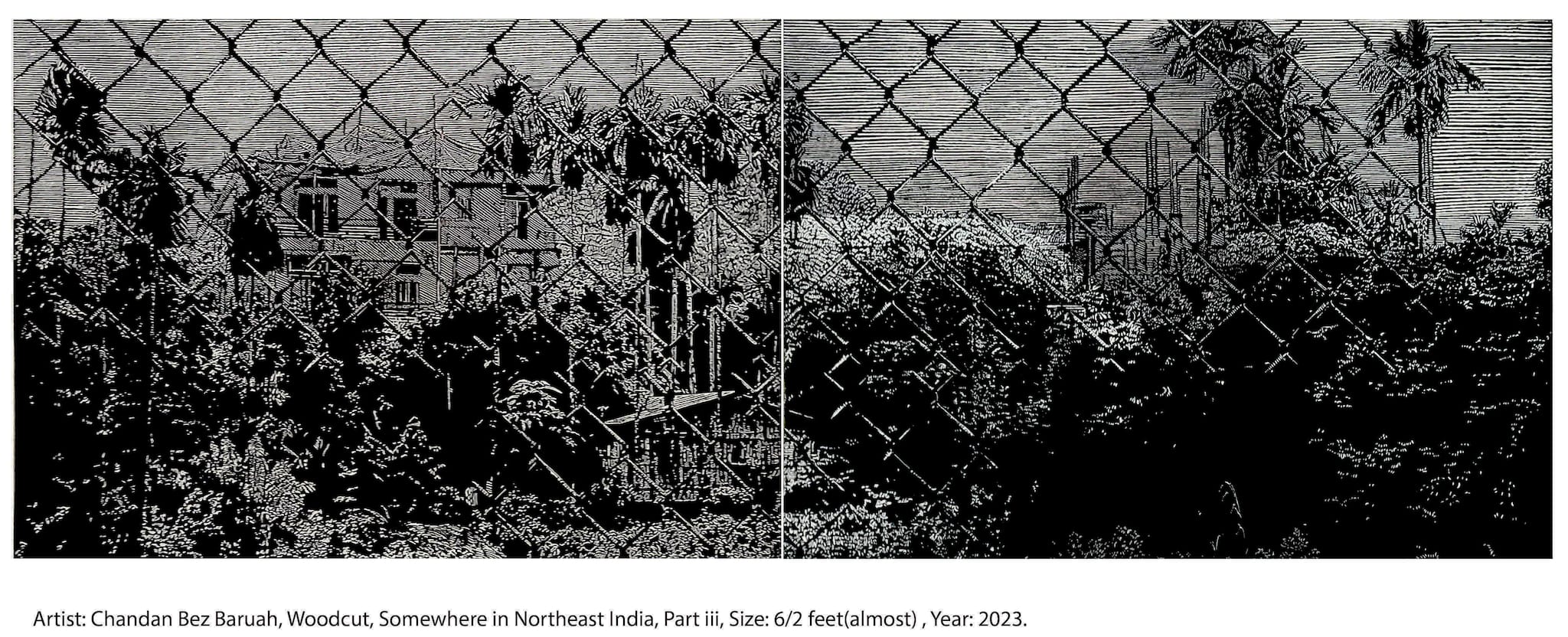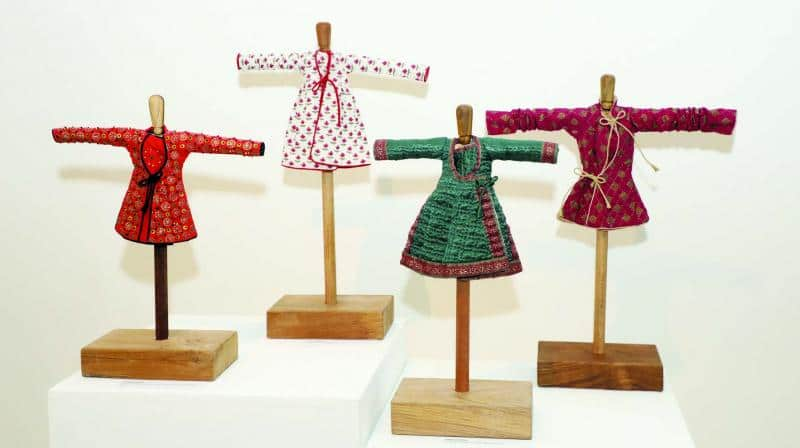



This weekend, the who’s who of the art world descended upon Bikaner House, which sits in the India Gate hexagon in central Delhi, to open the 7th edition of Delhi Contemporary Art Week (DCAW), on till September 4, to the public. This year’s show, with mixed media works of more than 100 artistes, both known and lesser known, from sculpture, paintings, installations, and more, is spread across three buildings in the vintage Bikaner House: “Threads That Bare”, a textile art show, in the main building; six galleries joining hands to co-exhibit their contemporary artistes (as well as some established names: MF Husain, Shilpa Gupta, Sudhir Patwardhan, Waswo X Waswo, among others) in the CCA building; and “A Bold Step Sideways”, a curated show by Mumbai-based art critic Girish Shahane, in the LTA building, next to Haldiram’s.
Actress Renuka Shahane’s brother and eminent writer Shanta Gokhale’s son, Girish, 55, laughs when I ask him how come as a Bombaywallah, he’s curating a show in arch-rival Delhi. “I’ve done a lot of work in Delhi, strangely. The big shows I’ve curated, have been in Delhi more than in Bombay. Besides, a lot of big galleries in Bombay share artists with galleries in Delhi,” he quips. If last year’s show, which he curated, had more artists he was familiar with, “this edition features artists who have come to prominence in the last 15 years. Some are mid-career but before 2010, they weren’t really known. I’ve come across a lot of new art practices and new artistes,” says Shahane, adding, “Personal narratives are very important.” In case, you are as confused as I was about where to start my exploration from, Shahane gives a tip: “the initial section of the exhibition is more abstract and the last section is more figurative.”
Seven years ago, in 2017, the art community and galleries in the National Capital came together to create the annual DCAW, with the aim to platform and push young and emerging artistes. In its seventh edition, it sticks to its vision, broadbasing it to include young artistes from across South Asia.
I, however, first go see “Threads That Bare”, a title coined by gallerist Bhavna Kakar of Latitude 28, and an accompanying curatorial note by textile designer Mayank Mansingh Kaul, who saunters about from one building to the other, clarifying that he has just written the note, not curated the textile-based art show, which is a joint effort by Delhi’s six leading galleries: Latitude 28, Gallery Espace, Exhibit 360, Blueprint 12, Shrine Empire, and Vadehra Art Gallery, showcasing 14 artistes. “From birth to death, it is ultimately fabric which wraps us,” notes Kaul, further adding, “The themes that the artistes articulate move from the intimately personal, emanating out of the familiar world of the domestic to that of community and public, variously bringing in comments on gender and the natural environment, among other concerns” and [displaying] the processes they bear and possibilities they bare.”
 Chandan Bez Baruah's 'Somewhere in the Northeast India, Part III' woodcut work.
Chandan Bez Baruah's 'Somewhere in the Northeast India, Part III' woodcut work.
Kaul’s words led me into the hall where each artwork, with its warp and weft, had a million stories to tell, only if we pause and look deeper. If Anita Dube’s metallic threads enveloped in black velvet were the scribblings of my unsettled mind projected on to a white wall, Osman Yousefzada’s textile fibres, coiled up like the veins of a human heart, only what appear as blood vessels take on the royal colour purple and deep violet. Ruby Chishti creatively reweaves time and memory in an exquisite and compelling fabric sculpture in A Tide Turns. In it, we see four-five women, whose backs are visible to us, and from behind they all look the same. She gives corporeality to found matter, uses recycled materials, broken ceramic pieces, pieces of old/discarded clothes, speaking of their past carriers and of a time bygone. All three are represented by Vadehra gallery.
Gallery Espace artist, Sydney-based Pakistan-born Afghan (Hazara) refugee Khadim Ali’s I’m the Third Script 2 is a stunning marriage between tapestry and Miniature art, takes the form and contemporises it. His oeuvre is a testimony of his family’s migrations from conflict zones, of loss and trauma. His colossal writing-on-the-wall artwork depicts conflict, birds clamour in the skies as people are on the run, carrying animals, as the fire-gripped land and trees rise up in flames. Ali embroiders on cotton and silk to weave his childhood memories on fabric.
 Miniature 18th-19th century royal attire by Geeta Khandelwal.
Miniature 18th-19th century royal attire by Geeta Khandelwal.
If Blueprint 12’s Geeta Khandelwal uses the art of quilt-making to recreate miniature royal garments from the 18th-19th centuries, Exhibit 320’s Sumakshi Singh’s uses old Zari (from once-have-been saris) to, in a very Japanese Kintsugi priciple way, create a life-sized bare-brick-wall structure that evinces the fragmented remains of demolished architectural facades from her post-Partition ancestral home in Delhi. Espace artist Viraj Khanna’s visually blurring the distinction between embroidery and painting and drawing on himself and his friends eating out as if in a social media post/Instagram reel is intriguing.
 Viraj Khanna in his own artwork, which blurs the distinction between embroidery and painting.
Viraj Khanna in his own artwork, which blurs the distinction between embroidery and painting.
Like a curious cat, I was strolling from one corridor into another, pouring in and out of rooms, soaking in all the exquisite art, with a side of off-key live old Hindi film music. Vibe un-checked. The six galleries have put up their artistes and their diverse works in the CCA, where I was headed next. A radiant Kiran Nadar walks out the minute I enter, with life beaming from her self-assured smile and bespectacled orbs, speaking of future artistic possibilities in the city.
“This time, as every time, Gallery Espace has a mix of senior, mid-level, career artists along with three very unknown ones, the first time is Soma [Surovi Jannat], she’s from Bangladesh and we are showing her for the first time. Ecology and environment are a recurring theme with a number of our artists, like Sonia Mehra Chawla, Ravi Agarwal, Rashmimala, Ishita Chakraborty. Ishita has shown at DCAW, this is her second time,” says Gallery Espace founder Renu Modi.
At CCA, if Espace’s Bengal-born, Zurich-based artist, Ishita Chakraborty’s Rhizome Notes, terracotta rhizomes, like uprooted stems implying forced displacement of a people from its land, beg your attention on the ground floor, on the first floor, a painting, showcasing south Indian transwomen in vibrant hues, by the Bengaluru-founded Aravani Art Project, presented by Blueprint 12, will transfix you. It’s a public art project brought inside the gallery. “The Aravani Art Project is a transgender artist community. We are showing them at the Venice Biennale (Biennale Arte 2024, April 20-November 24) currently. And I’m very happy that we are being able to showcase this marginalised section of society first time in a gallery space,” says Riddhi Bhalla, co-founder of Blueprint 12 gallery.
“At the 7th edition of DCAW, we are bringing together artists who are responding to preception, time and space. So, each of the artist is talking about how we perceive reality, owing to the environment we inhabit,” Bhalla adds.
Home is where the art is. It is a recurring theme in the works curated by Shahane at the LTA, where I arrive finally. “A Bold Step Sideways” brings in fresh voices, marking a departure from the art of the past, even as the Bombay Progressives still hold sway on our imagination. “Increasingly, artists are talking of family, parentage, community, home, land. It started before Covid but it got accelerated during Covid, just like the turn to painting. Many more artistes now are painting,” says Shahane, who keeps an eye out for how the artworks will look together in a curated show. “We [onlookers] are looking at the art, and art [works] should speak to us, but art should also be speaking to other art [works]. Then what you do is you just overhear that conversation. There should be a thematic and visual continuity,” he adds.
If Cincinnati-based Joya Mukerjee Logue, whose mother is American and father Indian, traces her own identity and her father’s ancestral roots in Bengal, making paintings out of her childhood memories, in sepia-hued and earthy tones, Delhi-based artist Harman Taneja, 30, an architect by profession, transformed into an artist in 2017, to eventually making art out of her demolished home. “I work with resin, it is my predominant material. A lot happened, COVID happened, and this [artwork] is a result of a 120-day residency in Baroda’s Space Studio. I was trying to control so many things, being an architect, there are so many constraints while designing a house, so resin came in handy and I was like, okay, this is liberating. And that’s why this [fluid, structure-less] material stuck with me. During COVID, I lost my mom and my house was to be demolished, not by choice. By pouring liquid [resin] over a grid, into home objects (water canister, bottle, vase, cleaning bottle), I break free from the shape of a home, by embedding the house that got demolished into my resin works. There was a certain social relationship between me and a house getting demolished. So, I keep visiting [houses that are being razed] to collect these [house-construction materials, broken pieces of bricks, stones, wood carvings/shavings] and they became part of my works,” says Taneja.
As an architect also, Taneja was designing in curvilinear spaces and not in rectilinearity, and wanted to break free of the structural restrictions as well as social constraints of “how you should design your life, that you have to get married and a man will earn for you.” Having undergone that she is breaking “free from that inchoate mould of life and societal pressures.”
Shahane says one last thing before seeing me out, “The fact that the galleries are collaborating on something like this and collaborating very successfully, that’s a great model for any town to have, because only one gallery can’t do it. That’s the crucial thing.”
Discover the latest Business News, Sensex, and Nifty updates. Obtain Personal Finance insights, tax queries, and expert opinions on Moneycontrol or download the Moneycontrol App to stay updated!
Find the best of Al News in one place, specially curated for you every weekend.
Stay on top of the latest tech trends and biggest startup news.